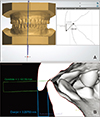Abstract
Objective
Methods
Results
Figures and Tables
Figure 1
Schematic overview of the design of the study. Laser OA, Digital model produced by laser scanning and measured with the Ortho Analyzer software; Laser DM, digital model produced by laser scanning and measured with the Digimodel software; CT OA, digital model produced by computed tomography (CT) scanning and measured with the Ortho Analyzer software; CT DM, digital model produced by CT scanning and measured with the Digimodel software.

Figure 2
A, Measuring the overbite by using the Ortho Analyzer software. B, Measuring the overjet and overbite by using the Digimodel software.

Table 2
Interexaminer comparison of measurements according to the paired t-test

Values are presented as mean ± standard deviation.
Laser OA, Digital model produced by laser scanning and measured with the Ortho Analyzer software; CT OA, digital model produced by computed tomography (CT) scanning and measured with the Ortho Analyzer software; Laser DM, digital model produced by laser scanning and measured with the Digimodel software; CT DM, digital model produced by CT scanning and measured with the Digimodel software.
Refer to Table 1 for parameter definitions.
*Statistically significant.
Table 3
Measurement accuracy and reliability between the plaster and digital models measured by examiner 1 according to ANOVA with Bonferroni correction as well as ICC

ICC, Intraclass coefficient correlation; Laser OA, digital model produced by laser scanning and measured with the Ortho Analyzer software; CT OA, digital model produced by computed tomography (CT) scanning and measured with the Ortho Analyzer software; Laser DM, digital model produced by laser scanning and measured with the Digimodel software; CT DM, digital model produced by CT scanning and measured with the Digimodel software; SD, standard deviation.
Refer to Table 1 for parameter definitions.
*By ANOVA.
Table 4
Bland-Altman analysis of the comparison between the plaster and digital models with 95% limits of agreement

Values are presented as mean difference ± standard deviation (minimum to maximum of 95% limits of agreement). Unit: mm.
Laser OA, Digital model produced by laser scanning and measured with the Ortho Analyzer software; CT OA, digital model produced by computed tomography (CT) scanning and measured with the Ortho Analyzer software; Laser DM, digital model produced by laser scanning and measured with the Digimodel software; CT DM, digital model produced by CT scanning and measured with the Digimodel software.
Refer to Table 1 for parameter definitions.
Table 5
Measurement accuracy and reliability between the digital models measured by examiner 1 according to ANOVA with Bonferroni correction as well as ICC

ICC, Intraclass coefficient correlation; Laser OA, digital model produced by laser scanning and measured with the Ortho Analyzer software; CT OA, digital model produced by computed tomography (CT) scanning and measured with the Ortho Analyzer software; Laser DM, digital model produced by laser scanning and measured with the Digimodel software; CT DM, digital model produced by CT scanning and measured with the Digimodel software; SD, standard deviation.
Refer to Table 1 for parameter definitions.
*By ANOVA.
Table 6
Bland-Altman analysis of the comparison between all types of digital models with 95% limits of agreement

Values are presented as mean difference ± standard deviation (minimum to maximum of 95% limits of agreement). Unit: mm.
Laser OA, Digital model produced by laser scanning and measured with the Ortho Analyzer software; CT OA, digital model produced by computed tomography (CT) scanning and measured with the Ortho Analyzer software; Laser DM, digital model produced by laser scanning and measured with the Digimodel software; CT DM, digital model produced by CT scanning and measured with the Digimodel software.
Refer to Table 1 for parameter definitions.
ACKNOWLEDGEMENTS
Notes
How to cite this article Camardella LT, Ongkosuwito EM, Penning EW, Kuijpers-Jagtman AM, Vilella OV, Breuning KH. Accuracy and reliability of measurements performed using two different software programs on digital models generated using laser and computed tomography plaster model scanners. Korean J Orthod 2020;50:13–25.




 PDF
PDF ePub
ePub Citation
Citation Print
Print




 XML Download
XML Download